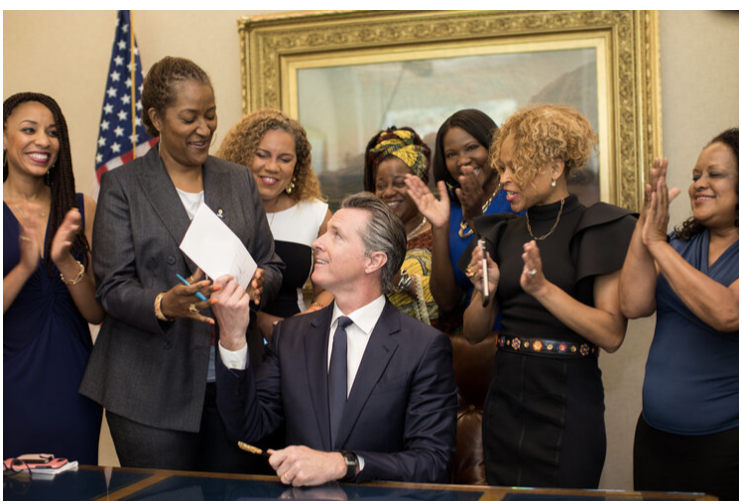It was a hot August morning in Louisiana. Twelve-year-old Faith Fennidy sat among her peers in class. Just as class was about to begin, a deep voice rang over the intercom: “Ms. Faith Fennidy, please report to the office.” Faith’s stomach filled with anxiety as she scurried down the hall. With no friendly hello or any explanation, the principal instructed Faith to pack up her belongings and leave school. As Faith learned that her braided hair extensions were the reason for this dismissal, tears began to stream down her cheeks. The school claimed they had warned Faith’s family before the school year started about the school’s new hair policy stating that only students’ natural hair was permitted; however, Faith’s family stated that one: they were not informed prior to school starting, and two: the new policy was racist, acting as a “barrier to entry for black people.” Little did Faith realize what would be waiting for girls like her in the professional world.
“You got the job” are four simple words. Yet, when strung together can have the power to open so many exciting possibilities. But, for Chastity Jones, those four little words would only offer possibilities on one condition — she had to cut off her dreadlocks. In 2010, Jones sat confidently in her suit and pumps, ready to impress the interviewers at an insurance company.

Chastity Jones (Photo by: Thinkstock)
Pleased by her education and experience, the company offered her the job as a customer service representative. Yet, immediately after the job was offered to her, the human resources department told her that she must change her hairstyle if she wished to work there. The hiring manager told Jones that dreadlocks were unprofessional as they “tend to get messy.” The manager likely did not realize the weight of this microaggression, yet to Jones, it certainly did not go unnoticed.
The hair-based discrimination that Jones faced didn’t begin in the office that day; rather, stigmas surrounding Black women’s hair stems back to the 1700’s in Louisiana. Black women, who were still enslaved at the time, covered their hair with rags due to the harsh nature of their work in the fields. However, in some cities like New Orleans, free Black women would style their hair in elaborate ways, adorning their textured hair with jewels and beads. However, this freedom of expression ended when the governor of Louisiana instituted the Tignon Laws, requiring Black women to cover their hair with a turban-like wrap. White men were seemingly attracted to Black women’s exotic hair styles which greatly upset White women; therefore, the law was designed to deter White men from being tempted by Black women. Despite the fact that these Black women were free in New Orleans, the Tignon Laws were also enforced to remind Black women that they were still part of the slave class. Some women, however, began utilizing the tignon as a fashion statement, refusing to let White society dictate their expression and appearance. One woman famously known for her unique tignon style was Marie Laveau.
While the Tignon Laws went out of effect in the 1800’s, Black women’s hair continued to be a relevant and controversial issue in society. After slavery was abolished in 1865, Black people felt pressures to adapt to mainstream society. Specifically, Black women felt that to fit into mainstream society, they had to start styling their hair like White women. This eventually led to the use of the hair-straightening comb, allowing Black women to iron out their kinky curls and achieve smooth hair textures like White women. History reveals that the hot comb was first used in Franceby hairdresser, Marcel Grateau, in an attempt to emulate Egyptian hairstyles; however, in 1920, Annie Malone and C.J Walker improved the structure of the comb in order to better accommodate thicker hair as well as different textures. Both Malone and Walker understood that the hot comb may be the key to giving Black women a fairer chance in society. The hot comb became extremely popular among Black women; however, it was not exactly an easy process to go through. Using the hot comb routinely on the hair was extremely painful. Dr. Christopher Papa stated that the combination of petroleum and intense heat of the hot comb caused inflammation and scarring on many Black women’s scalps. Today, if Black women wish to straighten their hair, there are less damaging ways to do so, but Malone and Walker certainly made a huge impact on the Black beauty industry when revolutionizing the hot comb.
But, around the time of the civil rights movement, Black women were tired of society’s Eurocentric beauty standards denigrating their appearances; thus, they said goodbye to straightening combs and hello to natural hair. Civil rights activists such as Angela Davis began wearing an afro, which became a powerful statement of the “Black is Beautiful” movement. Wearing an afro began to mean more than a hairstyle, it became a symbol of self-respect, self-love and unity within the Black community. While the Civil Rights Act of 1964 made it illegal to discriminate against based on sex, religion, national origin or race, no one foresaw that a clause about Black women’s hair needed to be included.
Like some of Civil Rights Movement leaders, Chastity Jones took a stand on what she believed in by refusing to change her hairstyle despite what society demanded. After the insurance company rescinded its job offer to Jones, the EEOC filed suit on her behalf arguing that the company was in violation of Title VII of the 1964 Civil Rights Act. The court, however, dismissed Jones’ case, claiming that hairstyles, unlike race, are changeable; therefore, retracting Jones’ job offer didn’t constitute racial discrimination. While Jones may have lost her individual battle, the fight against hair discrimination was certainly not over. Cases like Jones’ inspired the creation of the 2019 CROWN Act, which would protect against hair-based discrimination in schools, public areas, and the workplace.
The CROWN Act has been a crucial step in encouraging Black women to wear their hair naturally. Prior to the CROWN Act, women such as Marie Smith, a Black lawyer in New Jersey, were able to avoid workplace discrimination by simply refraining from wearing their hair naturally. Smith recalls straightening her hair for all interviews growing up in an attempt to avoid discrimination. But, with the creation of the CROWN Act, women such as Smith, Jones, and Fennidy can finally let their hair down.

Governor of California, Gavin Newsom, signs the CROWN Act into law (Photo by: The Official Campaign of the CROWN Act)
 NOLAbeings
Multimedia artist Claire Bangser created NOLAbeings as a portrait-based story project that marries...
NOLAbeings
Multimedia artist Claire Bangser created NOLAbeings as a portrait-based story project that marries...
 Data corner: Adobe Suite (create a PDF, social media graphic, presentation, edit a photo and video
Data corner is where you go to work with analytics and top tech skills. It takes on everything from PERL and SQL to Canva and Sprout Social.
Data corner: Adobe Suite (create a PDF, social media graphic, presentation, edit a photo and video
Data corner is where you go to work with analytics and top tech skills. It takes on everything from PERL and SQL to Canva and Sprout Social.
